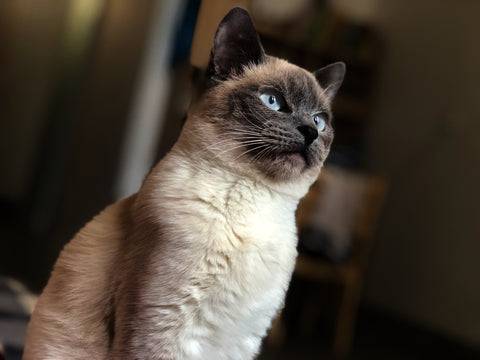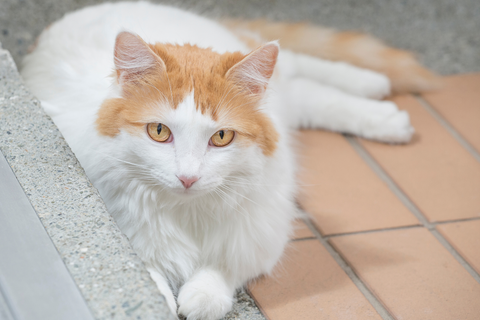
When these needs are met, cats are less likely to be stressed. When cats are less stressed, they tend to have fewer undesirable behaviors, and they will have a better chance to develop and maintain healthy social behavior.
The term "catification" is credited to Jackson Galaxy and his co-author Kate Benjamin in their book "Catification: Designing a Happy and Stylish Home for Your Cat (and You!)".
Hunting, Stalking, and Prey
Cats of today, much like their ancestors, have a strong prey drive and desire to hunt. A domestic house cat and large wild cats are very similar in stalking movements and techniques. And when we watch kittens pouncing and playing with each other, they do so very similar to even the largest cats of the African plains. Cats hunting, stalking, and prey drive remains throughout their lifetime. We generally do not recommend cats be allowed to wander outdoors unsupervised; therefore, domestic cats need us to facilitate the opportunity for our cats to release energy through play and hunting behaviors.
Use feeder toys that "hide" food and allow your cat to hunt and 'attack and obtain food rewards. Playing with these toys is a great way not only to help your cat tap into these instincts, but to create regular feeding cycles, feeding behaviors, and increased movement. All of which can help aging kitties feel young and playful!
Play
Finding the best toys for your cat is not always easy, and it may take some experimentation. Don't give up! Try different types, textures, sounds, and feels; they will be jumping, kicking, and pouncing in no time! For senior kitties, you likely already know what works. But if you have not tried many different types of toys for your cat, it is worth experimenting with.
Try to find toys that simulate air and ground prey both. Using fishing style toys is one great way to engage your cat and be a part of their playtime. When you leave for more extended periods, consider interactive toys that are remote activated, on timers, or motion-sensitive.
Some cats do enjoy catnip, and adding catnip to toys may increase play behaviors for these kitties. Not all cats find catnip attractive. If your cat does enjoy catnip though, and you have a green thumb, consider growing and drying your own! Growing these plants can be cost-effective and is a pretty addition to a home garden!
A great tool for cats is puzzle toys. Puzzle toys and feeders can help brains keep working and stay stimulated. They can help keep the cat's coordination, reaction, and muscle function working. There are lots of DIY ideas that are budget-friendly and can keep your cat engaged while playing. Often we think about dogs getting bored or needing a challenge, but we do not think about the fun and challenge cats need for enrichment as well! Look for toys, games, and treat dispensing toys that will challenge your cat mentally while they play.
Elevated Lounging
Cats like to be on elevated surfaces. They will frequently claim a space as their own on an elevated surface, and they can often be found napping or lounging in this area throughout the day. In the most perfectly "catified" spaces, cats can circumvent a space without ever having to touch the ground. Look at movement through a room from your cat's perspective and see if you can find an elevated path around the room. If not, see if you can create one. Would adding a few "floating" cat shelves and steps, a cat climber, and a few beams create a kitty course around the room that eliminates any need to touch the floor? This does not mean your cat will not use floor space, but it creates the best opportunity for your cat to navigate spaces with confidence. And when cats are confident, they tend to have fewer undesirable behaviors.
Along these elevated paths, your cat will want areas to lounge and leave their scent. These places create ownership of space and safe places for napping. Again, this creates a sense of confidence in the environment. Shelves, cat perches, furniture, cat beds, and hiders, as well as any other spaces you find your cat already tends to hide or sleep, is a great place to focus. Keep these areas comfortable and safe for your cat to create lounging spaces.
As cats age, they may need adjustments to their surfaces. Moving steps closer where they gain elevation, less jumping, and impact between surfaces, more padding where they lay most often, and consider heated surfaces as well. We want to continue to facilitate the need to be elevated but make it easier and safer for our feline friends to engage in these natural behaviors as they age.
Scratching Posts
Having vertical surfaces for scratching is essential for the best practice of catification and environmental enrichment. Cats have an instinct to scratch as a way of marking and creating the security of designation for their space. Cat trees, scratching posts, and even real wood all make great scratching surfaces for cats. Providing appropriate scratching surfaces and encouraging appropriate scratching can discourage inappropriate scratching.
Cats Are Not Small Dogs
It is funny how often I hear, "my cat thinks he is a dog" or "my cat acts like a dog" because they fetch, steal food, sleep under blankets, or other quirky behaviors. The truth is that the idea of a "lazy cat" is somewhat manifested in the media and normalized in society. Because cats are active for part of the night, they do sleep a good part of the day, that does not mean they should spend the entire day being lazy. Cats tend to do most activities in short bursts. Sleep, eat, play, physical interactions, all generally are short bursts that frequently happen throughout the day. Feeder eggs, interactive toys, timed food dispensers, and short grooming sessions will help to meet your cat's instincts.
Author's bio:
Beckie is a Registered Veterinary Technician living in Southport, NC. Beckie has enjoyed a diverse career in small animal, large animal, and mixed practices, academia, management and private consultant. Beckie is co-founder of Veterinary Advancements, a private consulting firm and is a professional medical responder with the ASPCA Cruelty Recovery Team. She is host of Clinician’s Brief the Podcast and co-hosts Veterinary Viewfinder and Making Sense of Pets podcasts. In support of her profession, Beckie is proud to serve as Executive Director for the Human Animal Bond Association, Member at Large for the Society for Veterinary Medical Ethics, and former Executive Board Member for both the national and state technician associations.




